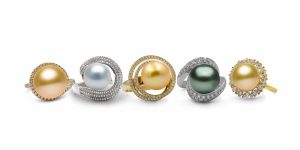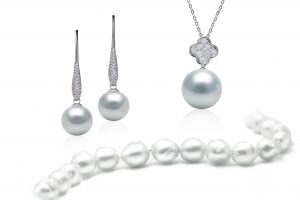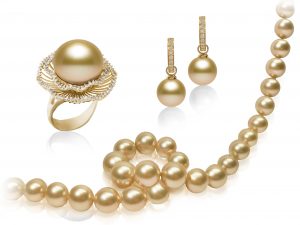
SALTWATER PEARL & FRESHWATER PEARL
Saltwater and Freshwater pearls may sometimes look similar, but they come from different type of shells.
Saltwater Pearls
Most of saltwater cultured pearls are grown with beads in pearl oysters which live in oceans. Saltwater pearl oysters are usually cultivated in protected lagoons or volcanic atolls. The trade name s of the cultured pearls are White or Golden South Sea, Black Tahitian and Akoya Pearls.
Freshwater Pearl
Freshwater pearls are cultured in various species of freshwater mussels rather than in oysters. Most of freshwater cultured pearls sold today come from lakes or rivers in China. They are less expensive than Akoya pearls. With modern freshwater cultivation methods, some freshwater pearls have excellent quality with excellent colour, shape and lustre.
SOUTHSEA PEARL & AKOYA PEARL
Southsea White Pearl
These pearls are cultured using larger oysters in the South Pacific and Indian Ocean. South Sea pearls are characterized by warm lustre and large sizes up to 14 mm in diameter. They are primarily produced in Western Australia.
South Sea white pearls are produced by the silver-lipped South Sea oyster. Harvested in sizes from 9mm up, their shapes range from round, oval or teardrop to free-form baroque.

Southsea Golden Pearl
Golden pearls are produced by the golden-lipped oyster. They have warm, natural golden colour, from light champagne to a very deep gold. Sizes are from 9mm and over, in round, oval, teardrop or baroque shapes.

Tahitian Black Pearl
Majority of Black pearls are produced by black-lipped oysters in the waters around Tahiti, in French Polynesia in the South Pacific. Black pearls range in colours such as black, grey, peacock green, eggplant colour, bronze, cream, pink and gold, size ranges from 11-12mm in diametre.
Akoya Pearl
Akoya pearls are produced by Japanese Akoya oysters. Akoya pearls are recognized for a very high lustre. The nacre layer is not as thick as freshwater pearls, but it has a very highly reflective surface with a mirror-like brilliance lustre. Colours range from white, cream and pink to light green, blue and silver. China has recently overtaken Japan in Akoya pearl production. These pearls usually range from 2mm to 10mm.
SHAPE AND COLOUR
Shapes
Pearls come in various shapes – round, semi-round, button, drop, pear, oval and baroque. Perfectly round pearls are the rarest and most valuable. Semi-rounds are also used in necklaces or in pieces. Button pearls are like a slightly flattened round pearl and can also make a necklace and in single pendants or earrings where the back half of the pearl is covered, making it looks like a larger, rounder pearl.
Pear shaped or teardrop pearls and are most often seen in earrings, pendants, or as a centre pearl in a necklace. Baroque pearls are irregular, unique and interesting shapes. They are also commonly used in necklaces.
Colours
While pearl colours are most commonly silver white or creamy white, others can be yellow, golden, pink, champagne, blue, green, black, lavender, multicolour and just about any colour you can think of in between. When referring to the colour of the pearl, it is the body of the pearl that is considered to be the primary shade.
To collect enough of rare colours such as purple pearls to form a complete string of the same size and same shade can take years.
NATURAL PEARL & CULTURED PEARL
Natural Pearl
Natural pearls form when a microscopic intruder accidentally enters in a shell and settles inside. The mollusk, being irritated by the intruder, forms a pearl sac of external mantle tissue cells and secretes nacre to cover the irritant. This secretion process is repeated many times and in the result it forms a pearl. Natural pearls vary in shape depending on the shape of the piece being coated.
Cultured Pearl
As the natural pearl is quite rare and very expensive, in the past couple of decades most pearls sold are cultured pearls.
Like natural pearls, cultured pearls grow inside of an oyster/mollusk with human intervention. A shell is carefully opened and an object such as a piece of tissue or a mother-of-pearl bead is inserted. Cultured pearls are often ‘pre-formed’ as they tend to follow the shape of the implanted shell bead nucleus. Cultured pearls can be distinguished from natural pearls by X-ray examination.
